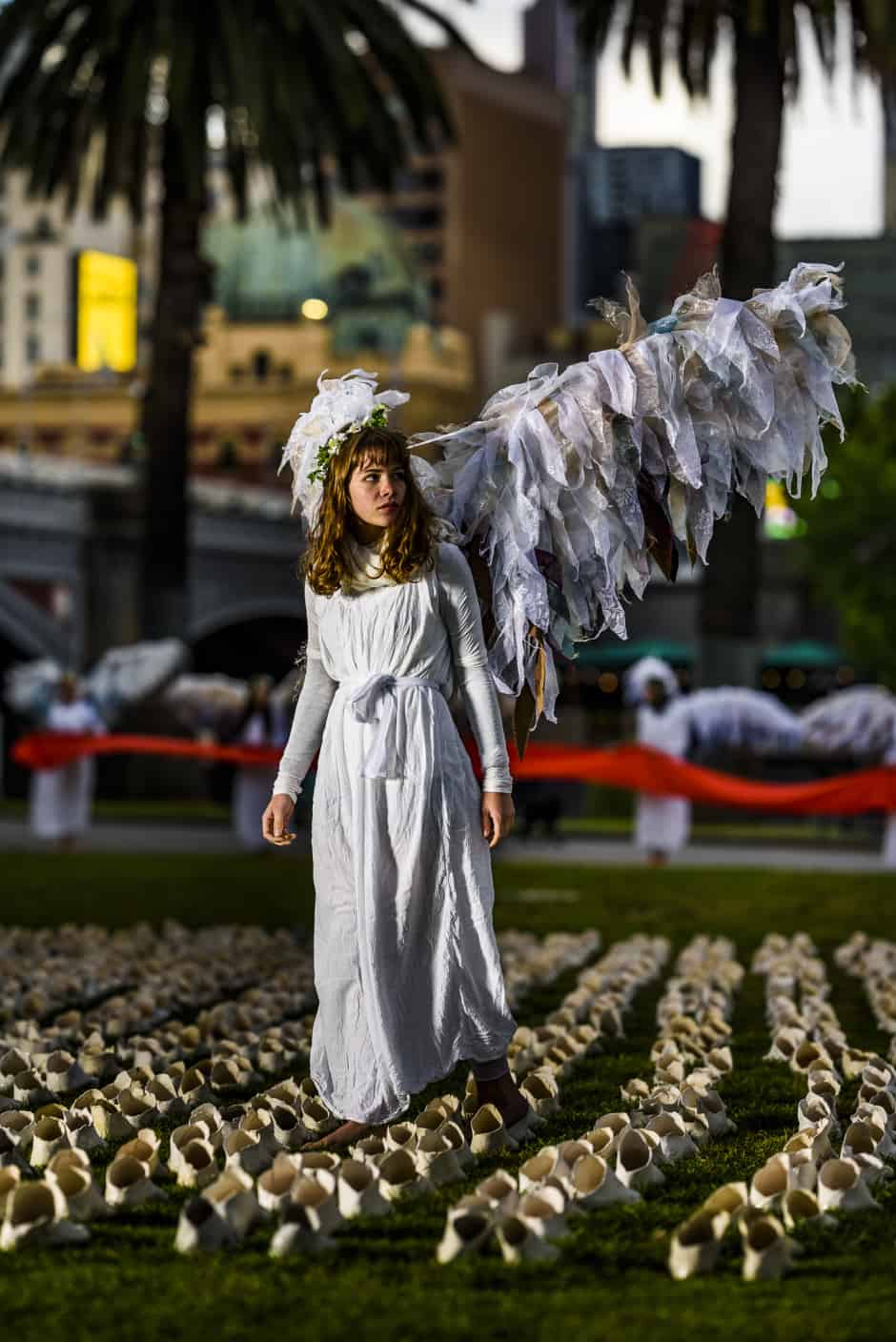
Image courtesy of Julian Meehan
As United Nations delegates were arriving for Day 1 of COP25 climate negotiations in Madrid, 624 pairs of hand cast clay skins from Bridget Nicholson’s Touch This Earth Lightly project lay in tight neat rows on the banks of the Yarra River opposite Federation Square in Melbourne, Australia.

Image courtesy of Julian Meehan
Why 624? To raise awareness and honour environment defenders who have lost their lives, estimated to be three people every week since The Paris Agreement (2015).

Image courtesy of Karena Goldfinch
Communities on the frontline of resource extraction are among the most vulnerable people in the world. In addition to facing extreme weather, fires, floods and droughts caused by the converging climate and ‘mass extermination’* crisis, corruption and the erosion of human rights and access to justice has made defending the environment extremely dangerous.

Image courtesy of Julian Meehan
Ten years ago, in the lead up to COP15 in Copenhagen, Melbourne based artist Bridget Nicholson began her Touch This Earth Lightly project to “delve into the emotional and cultural connections people have to land, to place and the natural world around them.” What often emerged were deeply personal stories of anguish and powerlessness – in many cases of overwhelming solastalgia, – over threatened, damaged or destroyed local environments. Nicholson’s findings are also backed by numerous major global research projects showing that all aspects of physical and mental human health depend on a healthy environment.

Image courtesy of Julian Meehan
Nicholson has also lived and worked in places where the local environment is under threat and yet where jobs are desperately needed. She seeks “ways of engaging with people that allow for frank conversations where emotions can be described in a safe place. A place where there is an understanding of the connection between people and the environment, and a desire to explore how we can meet our needs in harmony with nature.” She finds it absolutely shocking that people are losing their lives protecting the environment – that is priceless – from predatory industries.

Image courtesy of Julian Meehan
Collaborating with the Climate Guardians (who performed in Paris during COP21 that led to The Paris Agreement) on the eve of COP25 negotiations gave Nicholson the opportunity “to ask Nations to stop the exploitation and annihilation of minority groups, and to find a way to ensure that all peoples have the democratic right to speak for themselves and their environments.” She also hopes that “the global community may work as a whole to protect and sustain a collective environment for the future.”

Image courtesy of Julian Meehan
By every measure it’s appalling that US$4.7 trillion in global taxpayer subsidies are propping up ecocidal industries that are still making massive profits from exploiting fossil fuels. It is beyond morally reprehensible for obscenely wealthy and powerful companies largely responsible for excess greenhouse gas to be corrupting democratic processes (destroying the fabric of societies everywhere) to allow their ‘business as usual’ model to continue as the world faces a climate emergency.

Image courtesy of Andrew Laird
COP25 provides an exceptional opportunity to draw attention to the nearly 2,000 jurisdictions and local governments who have already signed on to the Climate Emergency Declaration since late April 2019. It also provides the opportunity to propose forceful resolutions demanding that polluters take responsibility for naturally drawing down their share of legacy greenhouse gas as fast as humanly possible.

Image courtesy of Julian Meehan

Image courtesy of Julian Meehan
Further to this (adopting the same community led model as the Climate Emergency Declaration) we propose that all companies seeking to profit from resources extraction and the associated exploitation of local community labour be legally bound by fully transparent, accountable and cooperatively established agreements underpinned by the Climate Emergency Declaration, and the UN’s Universal Declaration of Human Rights.

Image courtesy of Karena Goldfinch
Given the ties between climate, environment and social justice, such agreements would require that at least 51 per cent of all projects be cooperatively owned and controlled by the local community with impact investors, fair-minded financiers and commercial operators, and NGOs serving as minority partners. Moreover, based on long established cooperative business models, community driven projects would be expected to make fair profits, and to pay reasonable wages.

Image courtesy of Julian Meehan
The key difference to the ‘business as usual’ model would be that both people and nature would be better protected, and local communities would be incentivised and rewarded by socially and ecologically sustainable projects.

Images courtesy of Julian Meehan
Major advances in science and sustainable technologies – coupled with indigenous wisdom and collaborative modes of democratically organising – are already making it possible for local communities to live healthier and more fulfilling lives. The challenge is to spread these collaborative models around the globe. At the end of the day we simply need ecocidal industries and their enablers to get out of our way – fast.

This Red Line fabric helped lead a crowd of more than 10,000 through the streets of Paris on D12 of COP21 (2015). Activists from all around the world had marched that Red Line around five kms from L’avenue de la Grande Armée to the Eifel Tower where the bridge over the River Seine was occupied for more than an hour. The Red Line symbolises a crossing of the Earth’s critical physical and social limits; it marks a non-negotiable no go zone where wholesale systems collapse. Image courtesy of Karena Goldfinch
In addition to the wonderful Angels (in and out of costumes), we gratefully acknowledge photographers Julian Meehan and Karena Goldfinch, and the support of CLIMARTE.
* It’s wrong to call this a mass extinction because, unlike previous events in our Earth’s history when species have died on mass, the consequences of ecocidal industry practices have been well understood since mid last century.

